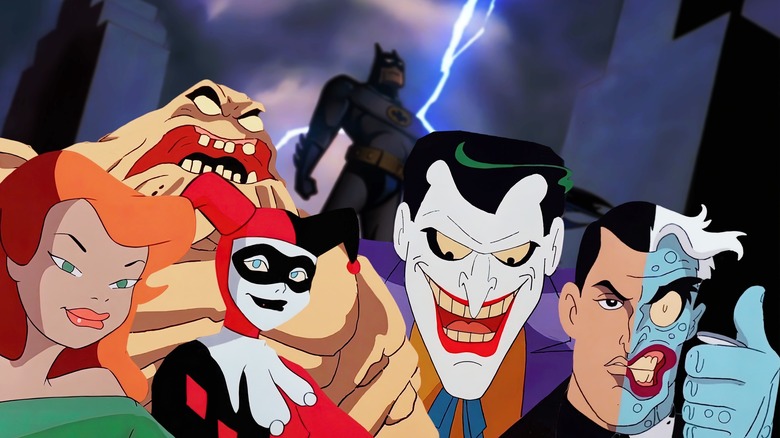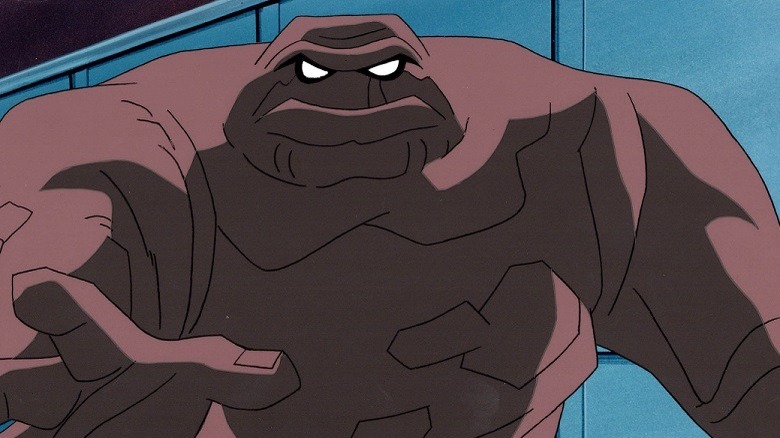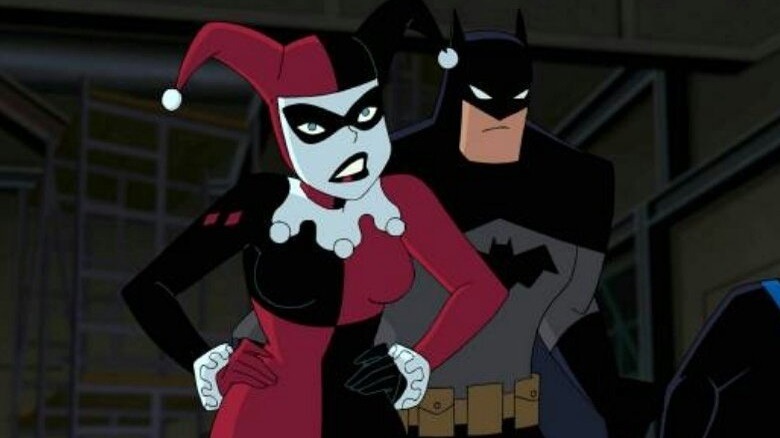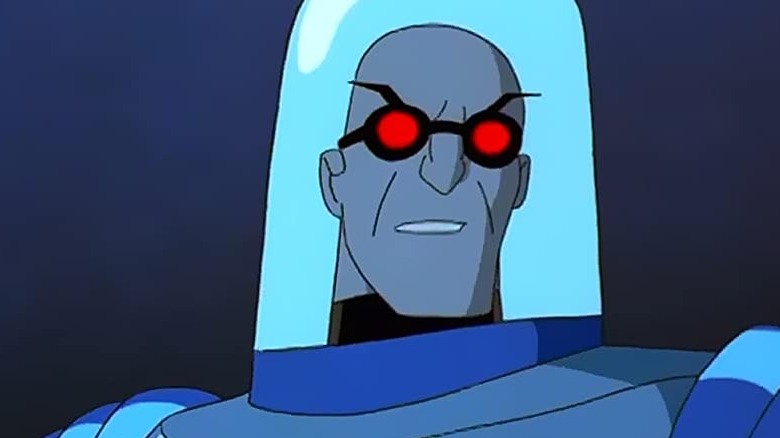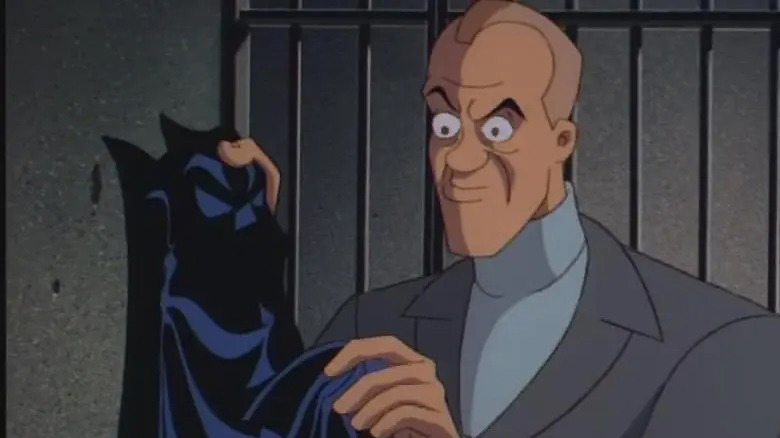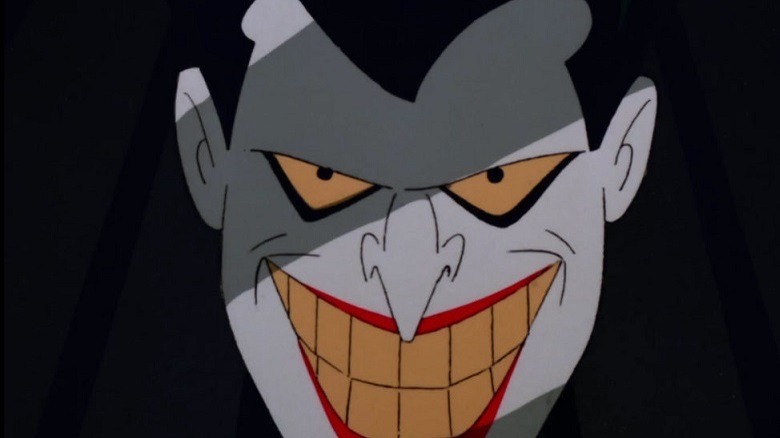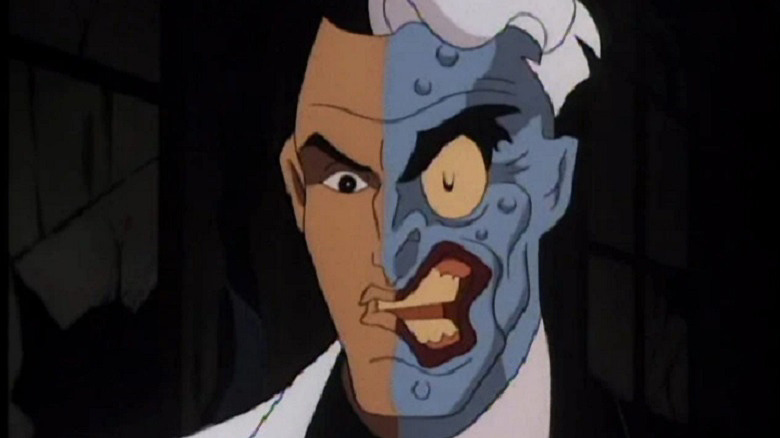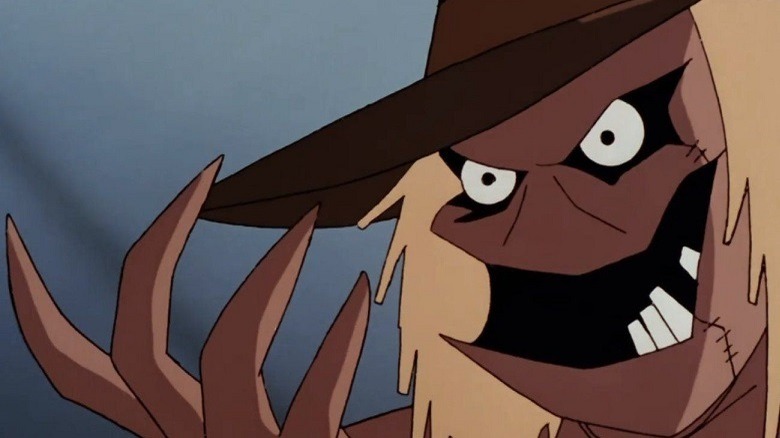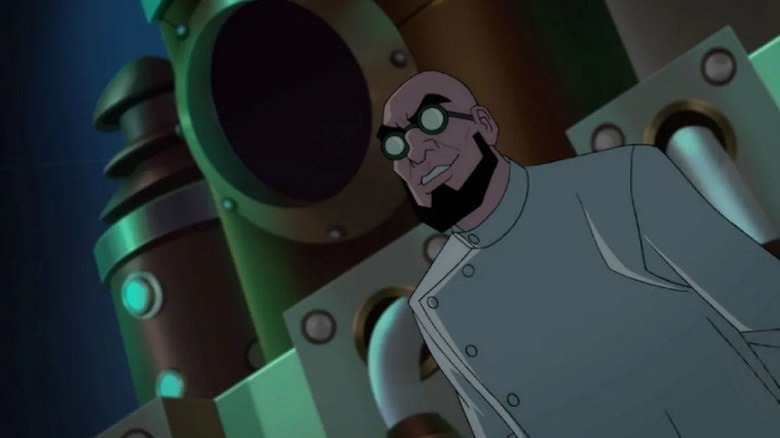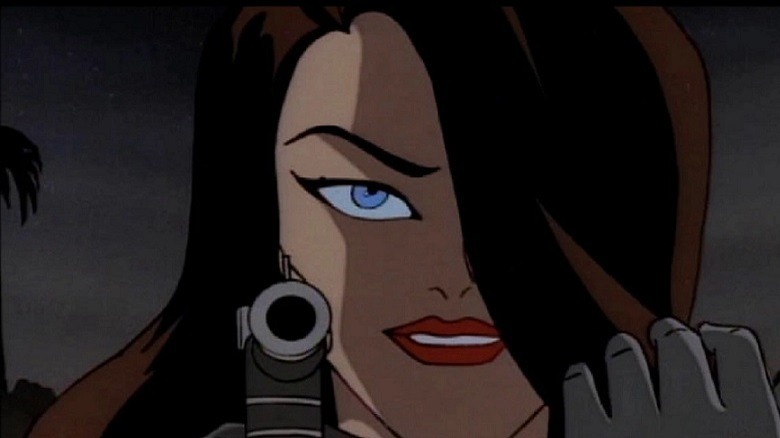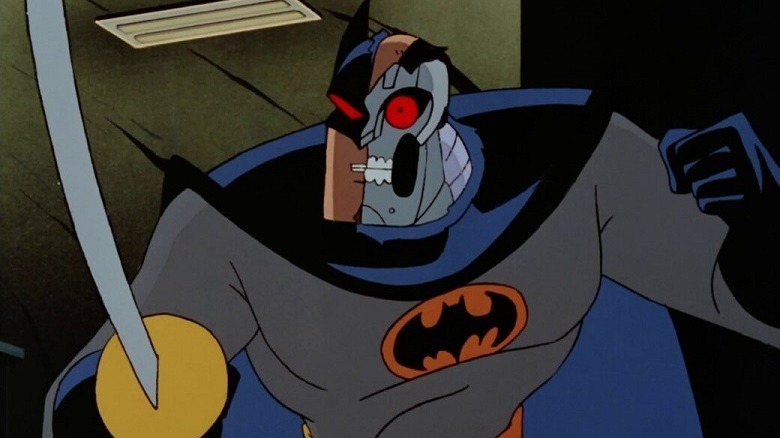The 10 Coolest Batman: The Animated Series Villains
Hitting TV screens in 1992, "Batman: The Animated Series" towered with pointed bat ears over the standard superhero cartoon fare of the time. Taking influence from Alfred Hitchcock movies, it had a distinctive look all its own — stylized and bold character designs, and a gothic noir Gotham setting. With the incredible visuals topped with deeper and darker scripts performed by a capable voice cast (including the sadly missed Kevin Conroy), it would go on to huge success — spawning similarly styled cartoons featuring Superman and the Justice League, and a raft of "Batman" spinoffs.
Setting its stall with a memorable opening sequence — following the exploits of two foiled robbers meeting with the Caped Crusader on a moonlit rooftop — a distinctive Danny Elfman theme proudly declared that "Batman: The Animated Series" would aim to be a worthwhile adaptation. However, any superhero is only as interesting as their villains — but luckily Batman has one of the most disparate and entertaining collections of rogues of them all, with the '90s animated series drawing on several decades of source material.
With such a cornucopia of crooked criminals, some would obviously stand out more than others. Many of the characters were drawn directly from comic book pages, and some were invented solely for the cartoon. Let's fire up the Bat Computer and look at the 10 coolest villains to ever trouble the streets of Gotham City.
Clayface
Several individuals have terrorized Gotham under the alter ego of Clayface over the character's decades-long history, but it was Matt Hagen who debuted in "Batman: The Animated Series" in 1992's superlative "Feat of Clay." Whereas in the Silver Age source material, Matt Hagen was a ruthless treasure hunter, the animated series had Matt as a failed actor, taking influence from Basil Karlo, the first comic book Clayface.
After an accident left him horrifically burned, exposure to an experimental compound granted Hagen the ability to shift his now clay-like malleable form — and Clayface's invulnerability, heightened strength, and improved stamina made him a potent foe for the Caped Crusader. Like many of the individuals in Batman's rogues gallery, Clayface is ultimately a figure of pity, forced to live his life as a freak, cursed by circumstances beyond his control.
Voiced by genre-favorite Ron Perlman, he endows Clayface with the same sympathetic tones that his portrayal of Hellboy encompassed — a monster feared by many, forced to shun society. His powers, though, mark him as one of the more interesting villains — a product of the Silver Age of comics, which added more science fiction and fantastical elements into the genre. To be able to extend or retract his limbs at will, to be able to morph himself into other individuals, and even split his consciousness between different bodies, makes him an intriguing — and delightfully formidable — adversary.
Harley Quinn
It's hard to imagine a DC universe without Harley Quinn. She's virtually omnipresent through her acolytes at conventions around the globe, as ubiquitous as Deadpool in the imitation stakes as swathes of cosplayers portray Quinn's various incarnations. The character has also proven to be the most interesting aspect of several live-action DC projects, and her own spinoff cartoon series also proved to be quite a pleasant surprise.
She's a rare thing in "Batman: The Animated Series" — a character with no origin in the comics, (created as a gangsters' moll style character for the Joker) with both the Clown Prince of Crime and Harley Quinn making their animated debut in 1992's "Joker's Favor." She would, however, deservedly make her way into Batman comics, first appearing in print a year later in "Batman Adventures."
Putting aside the labored reworking of the character's actual name Doctor Harleen Quinzel (come back, Edward Nygma, all is forgiven), the evolution of Harley has been fascinating. She's come a long way from her humble beginnings clothed in black and red as a traditional court jester, as an infatuated woman obsessed with the Joker. She was a character to pity, in a toxic romantic relationship where respect was far from mutual. However, with every one of her animated series appearances, her individuality – and sense of agency – continued to build, making her an effortlessly cool character in her own right.
Mister Freeze
Cool in literally every sense of the word, this nippy ne'er-do-well has been a thorn in Batman's side since 1959 (when he appeared as "Mister Zero," renamed Freeze in the Adam West live-action TV series six years later). Despite Arnold Schwarzenegger's campy performance in 1997's "Batman & Robin," Mister Freeze (real name: Doctor Victor Fries) remains as interesting — and appropriately, as chilling — as ever. Appearing in Season 1's "Heart of Ice," Mister Freeze's animated debut was the first episode of the series to win an Emmy (but "Batman: The Animated Series" would go on to earn another three during its two-season run).
In reality, prolonged exposure to dangerous unstable chemicals would more than likely maim or kill you — however, like many other comic book heroes and villains, here they give you superpowers. Victor Fries' particular chemical concoction collision led to him being unable to survive in anything other than sub-zero temperatures, forcing him to live inside his cryogenic suit.
His backstory is sympathetic, necessity forcing him into a life of crime to earn the funds to find a cure for his comatose wife Nora. As such, his deeper motivations make him a villain worthy of note. Just try not to think too hard about Arnie's gaudy neon live-action Teutonic delivery of lines such as "The Iceman Cometh!" or "Chill!"
Josiah Wormwood
In the Golden age of Batman — and the Adam West-starring TV series from the 1960s — very few Batman villains could resist a good old-fashioned trap. Admittedly, a lot of them would be overly confident in their traps' effectiveness and simply wander off, allowing the Caped Crusader to escape, but there was no denying the appeal of watching our dynamic duo lowered into piranha-populated pools and the like.
For Josiah Wormwood (also known "The Interrogator"), traps were his raison d'être. Introduced in 1975 in issue 450 of "Detective Comics" (albeit named Jeremy rather than Josiah), his criminal goals were achieved by capturing people and forcing them to surrender their valuables, before they met their fate in his cruel deathtraps.
In his sole episode, "The Cape and Cowl Conspiracy," Wormwood is tasked with stealing the prized possessions of the greatest prey of all — the Dark Knight. Josiah may on the surface appear to be a coward content with hiding behind his riddles and snares, but it's arguable that he managed to best the Bat with one particular trap — and also held his own in melee combat against the hero. It'll be small solace to the trap-maker in his cold nights in Gotham City Jail, but he can at least claim the kudos of having (sort of) beaten the Batman — and that one assertion marks him as a markedly (suitably cowled) head and shoulders above the riffraff of the rogues gallery.
The Joker
An inevitable entry cemented in perpetuity for assorted reasons. As the Yin to Batman's Yang, this grease-painted genocidal jester is as important as the Caped Crusader himself, the two of them inexorably locked in a never-ending conflict. It's a character also made infinitely more memorable via the sheer quality of its performance — Mark Hammill's portrayal is arguably the definitive take on the murderous maniac.
With an origin tale as unknowable as the Joker himself — "If I'm going to have a past, I prefer it to be multiple choice!" as announced in the graphic novel "The Killing Joke" — he's one of Batman's oldest foes. Debuting in the first 1940 issue of the "Batman" comic, he was slated to be killed off in that same issue — but editorial involvement saw that the psychotic Scaramouch would go on to be the bane of the Bat for quite some time.
Appearing alongside Harley Quinn in 1992's "Joker's Favor," the Joker would go on to be a series regular, as is befitting a character with such prestigious importance in the "Batman" mythos. Hamill would go on to reprise his role a great many times after the series ended, appearing alongside actor Kevin Conroy in spinoffs and the popular "Batman: Arkham" video game franchise. Conroy and Hamill had a rule for recording Batman and Joker's conversations, doing their lines together to get the best performances possible. It's a fitting validation of the excellence of the villain that his relationship with the lead made the series what it was. And how cool is that?
Two-Face
There's an interesting work by Dr. Travis Langley — "Batman and Psychology: A Dark and Stormy Knight" — in which the psychology professor explains that many denizens of Batman's rogues gallery have their origins in mental illness. Few villains demonstrate that more clearly than Harvey Dent — Dissociative Identity Disorder gives him dual personalities and the foreboding alias of "Two-Face."
Debuting in "Detective Comics" #66 in 1942, District Attorney Dent had a vial of acid thrown at his face by a mob boss, hideously disfiguring one half of it, driving him insane and giving him a twisted sense of justice. He continued to punish, but his actions were now decided by the flip of a coin — one side untarnished, one side as scarred as he was.
In the animated series, he made his debut as Harvey Dent in the Man-Bat heavy episode "On Leather Wings," but it wouldn't be until the aptly-titled two-part episode "Two-Face" that we would witness his sad transformation from a brilliant lawyer and close friend of Bruce Wayne into the dichotomized delinquent. The nature of Dent's duality makes for a curious character of surprising depth, with the duplicitous DA frequently coming over as more anti-hero than villain — and the fact that Bruce and Dent were once friends adds a further tragic layer of backstory. There's a lot more to Two-Face than first appears, hence his frequent appearances in the pantheon of Batman's best villains.
The Scarecrow
Considering that the sole purpose of Batman's particular choice of nocturnal attire was to strike terror into the hearts of criminals, there's a delicious irony to the fact that one of his most memorable villains uses fear as the primary weapon in his arsenal. The Scarecrow first appeared in 1941's "World's Finest Comics" Volume 3. His alter ego was Doctor Jonathan Crane, a disgraced and obsessed professor of psychology, who used chemicals and psychological warfare to exploit the fears of his enemies.
Not content with lounging in a field and keeping crows from nibbling on crops, the Scarecrow was forever looking for new ways to test his exhaustive research, eventually concocting a fear toxin — a pheromone that would cause vivid and terrifying hallucinations in whoever was unlucky enough to inhale it. Debuting in the Season 1 episode "Nothing to Fear," you'd think that Crane's unnerving appearance — a raggedy and spindly scarecrow-like figure with blank eyes — would be terrifying enough on its own, but the toxin is what finishes off the people of Gotham.
Scarecrow's popularity endures, with the character appearing in a great many DC adaptations — notably played by horror stalwart Jeffrey Combs in "The New Batman Adventures" and other projects, and by Cillian Murphy in Christopher Nolan's live-action reboot, "Batman Begins." It's easy to understand the villain's acclaim, possessing a power that nobody is safe from, as everybody fears something — even the ever-stoic Batman.
Hugo Strange
Any psychiatrist worth his salt would have a field day psychoanalyzing the disparate individuals in Batman's rogues gallery, but one suspects there'd be enough content for several dozen clinical papers worth of material about just the Caped Crusader alone. A billionaire who chooses to spend his evenings dressed as a winged mammal trying to scare the bejeezus out of the criminal underworld? No wonder Doctor Hugo Strange became a little infatuated with the Dark Knight, turning himself into a psychotic criminal in the process. He's one of the longest-running villains in Bat-continuity, having first appeared in 1940 in "Detective Comics" #36, albeit as more of a traditional criminal mad scientist in his comics debut.
Appearing in just a single episode — "The Strange Secret of Bruce Wayne" — the character nonetheless makes a significant impact, with Hugo being one of the few individuals to learn of Batman's real identity. Armed with a device he created that could read his patients' memories, he used this information for extortion purposes — and in Bruce Wayne's case, learned a secret that he couldn't convince anybody else to believe.
Despite his fleeting visit to "Batman: The Animated Series," Doctor Hugo Strange features on this list predominantly for achieving in a single episode what the rest of the rogues gallery has failed to do for decades — which marks him down as a formidable and worthy opponent for the Batman.
Talia al Ghul
Despite appearing late in the series — towards the end of Season 1 in the episode "Off Balance" — this member of the Society of Shadows proved to be quite a formidable foil for Batman, as both antagonist and romantic interest. The daughter of Ra's al Ghul (voiced by the sadly departed David Warner) brought a daring new edge to the series — episodes featuring this fearsome femme fatale were more about espionage than superpowers, tangentially taking the series along a welcome "James Bond" route.
Her father may have had his immortality and armies of assassins, but nobody could catch Bruce off his guard quite like Talia. Romance was rarely on the cards for Bruce — whose exploits with women were more of a cover for his fake playboy lifestyle than genuine love — and Talia got under his skin more than once. Even the immortal Ra's saw the potential in having Bruce become his successor, and Talia found herself the unwitting pawn in that scheme.
A fierce combatant more than capable of holding her own, she's a worthy addition to Batman's rogues gallery — with additional depth through emotional connections that none of the other miscreants could ever claim. The comics and subsequent exploits into animation after the conclusion of "Batman: The Animated Series" went even further, with Talia becoming the mother to Bruce's eventual son.
H.A.R.D.A.C.
You'd be forgiven for passing H.A.R.D.A.C. (Holographic Analytical Reciprocating Digital Computer) off as just another stereotypical villain based on a computer gone bad, with a labored acronym for a name — but it's not until the awry A.I.'s next appearance in the episode "His Silicon Soul" that a truly fascinating villain is born.
Injured while trying to stop a raid on a technology-laden warehouse, Batman discovers that he is a robot. Realizing over time that he isn't in fact the actual Batman, but a long-abandoned cybernetic duplicate of the Caped Crusader. As he tries to learn the secrets of his creation, he meets his creator — Karl Rossum — who, in an elegant link to the similarly-themed "Blade Runner," is voiced by William Sanderson, who played replicant designer J.F. Sebastian in that movie.
Pitting heroes against duplicates — or darker, twisted variants of themselves — is commonplace in comic books, but what makes the H.A.R.D.A.C. robot an interesting twist is that this digital doppelganger genuinely believes for a while that he is Batman, equipped with all his memories, feelings, talents, and skills. The final confrontation sees Batman pitted against a smarter, faster, and more callous version of himself — and that makes for a truly great and memorable adversary and reminds us of the values that make Batman more than merely a reckless agent of justice.
